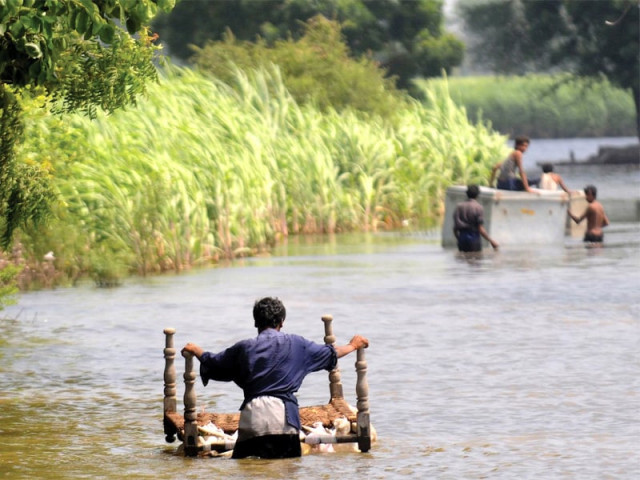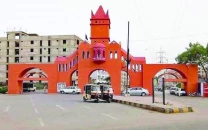Joint venture: WB to pay as Sindh strengthens drains before next monsoons
Rainwater begins receding as govt prepares legislation against land grabbing.

Joint venture: WB to pay as Sindh strengthens drains before next monsoons
The World Bank is set to fund the Sindh government as it attempts to strengthen drains and canals and remove encroachments before the upcoming monsoon season.
“The World Bank has promised two billion rupees to strengthen the irrigation network, including canals, drains and regulators,” Sindh Irrigation Minister Jam Saifullah Dhareejo told the media gathered at the Sindh Secretariat shortly after meeting with a World Bank delegation.
He said that they have already begun a project called the Sindh Water Sector Improvement Programme worth $175 million. The programme aims to improve the water and drainage sector of which Rs2 billion are to be spent on strengthening canals and drains.
“We will work on the Ghotki Canal, Nara Canal and the Left Bank Outfall Drain (LBOD) among others,” he said. The first order of business, however, is to conduct a study on the left side of the River Indus where 8.1 million people have been rendered homeless.
“An American company, Louis Berger, will conduct a study on how to strengthen these canals and drains.”
The LBOD’s total capacity is around 4,000 cusecs but 15,000 cusecs of water are being released into it. “We can expand the capacity of these canals based on the recommendations of the study,” the minister added.
He said that Word Bank financed the LBOD in the first place. The drain carries saline water from a number of districts on the river’s left bank and drains into the Arabian Sea in Badin district. Due to design faults, it fails to do its job after storms and cyclones and this causes great devastation. Dharejo refused to comment on why the government did not lodge a complaint with the World Bank or hold them responsible for the defective design. “It was not built to carry storm water, it has been built to dispose of saline water,” he explained.
The irrigation minister went on to say that the rains Sindh experienced this year are ‘historic’ and were the worst catastrophe faced by the province in its 150-year history. He estimated the losses suffered by his department at Rs6.5 billion. “The government is vigilant. No one drowned - most of the deaths were due to roof collapses and short circuits. A few of them died of hunger too.” Comparing the figure to the 1,500 who died in Khybyer Pakhtunkhwa last year, Dharejo felt that the Sindh government dealt with the situation well with the minimum loss of life.
Rainwater starts to recede
“This all has happened due to global warming. We have taken measures and I want to share with you the good news that the water collected in the Badin, Mirpurkhas, Benazirabad and Sanghar districts has begun to recede,” he said.
Dharejo was confident that all channels and canals will be restored in time for the upcoming Rabi season and people would be able to sow their crops. Moving on to encroachments, the minister said that the government has decided to remove all illegal settlements on canals and drains and are to make a legislation on it soon.
“We will suggest a strict punishment against those land grabbers who have occupied canals and drains in Sindh,” he said. The study of the canals will also indicate what the biggest obstacle is and how to remove it.
Published in The Express Tribune, September 28th, 2011.



















COMMENTS
Comments are moderated and generally will be posted if they are on-topic and not abusive.
For more information, please see our Comments FAQ